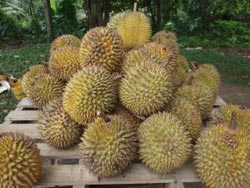Durian (Durio zibethinus L.) shell and Banana Pseudostem Fibers

Copyright : Kalai / CC<br>
This study explored the use of inexpensive materials as alternatives to treat effluents from various industries such as petroleum, metals, food processing, textile, industries as well as municipal waste waters and has become a global environmental issue.
This study explored the use of inexpensive materials as alternatives to treat effluents from various industries such as petroleum, metals, food processing, textile, industries as well as municipal wastewaters and has become a global environmental issue.
These effluents containing oil can cause serious detrimental environmental impact on the receptor water bodies and induces detrimental effects to aquatic life. It also causes serious problems to wastewater treatment plants due to its high stability and it can be separated only with the help of chemical clarification. Batch adsorption study was conducted to evaluate efficiencies of two different agriculture wastes as micro sorbent to remove oil from aqueous solution.
The agriculture waste used in this study was Durian Shell (DS) and Banana Pseudostems (BPS).
Durian shell and Banana Pseudostems are naturally occurring plants found abundantly in Malaysia. The durian fruit is a seasonal fruit which emits a pungent smell and is commonly referred to as the “King of Fruits”. The banana fruit is a non seasonal fruit and is found in abundance in Malaysia. A detailed batch study to determine its adsorption equilibrium, isotherm and kinetics was carried out at ambient temperatures, various initial concentrations of oil and stirring time. Banana pseudostem was found to be more effective than Durian Shell in removing oil from water.
Langmuir and Freundlich adsorption model were applied to describe the experimental isotherm and isotherm constants. The kinetic data was best fitted to the pseudo-second-order kinetic model. The role of DS and BPS in the removal of oil from aqueous wastes was investigated.
The researchers concluded that BPS performed exceptionally well to remove oil from aqueous solution as compared to DS.
Langmuir and Freundlich adsorption model were applied to describe the experimental isotherm and isotherm constants. Equilibrium data fitted well with Freundlich model. Thus it is reasonable to conclude that the adsorption of oil on both adsorbents that consist of heterogeneous adsorption sites are similar to each other in respect of the adsorption phenomenon. Kinetic studies indicated that the sorption of oil tend to follow pseudosecond- order kinetics for the range of studied concentrations.
This study is hoped to give rise to new avenues of exploring the possibility of using inexpensive materials to remove oil from aqueous solution.
Contact Information:
Nurul Izza Husin,
Department of Applied Sciences, UiTM Malaysia.
nurulizza.husin@ppinang.uitm.edu.my
Media Contact
All latest news from the category: Agricultural and Forestry Science
Newest articles

New model of neuronal circuit provides insight on eye movement
Working with week-old zebrafish larva, researchers at Weill Cornell Medicine and colleagues decoded how the connections formed by a network of neurons in the brainstem guide the fishes’ gaze. The…

Innovative protocol maps NMDA receptors in Alzheimer’s-Affected brains
Researchers from the Institute for Neurosciences (IN), a joint center of the Miguel Hernández University of Elche (UMH) and the Spanish National Research Council (CSIC), who are also part of…

New insights into sleep
…uncover key mechanisms related to cognitive function. Discovery suggests broad implications for giving brain a boost. While it’s well known that sleep enhances cognitive performance, the underlying neural mechanisms, particularly…



